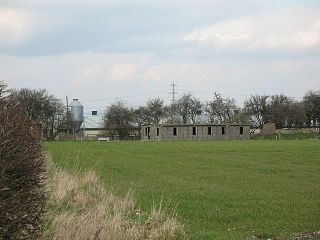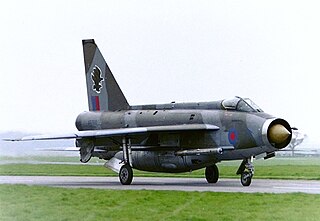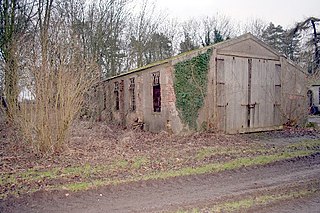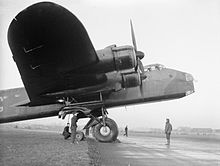
Royal Air Force Kenley, more commonly known as RAF Kenley is a former airfield station of the Royal Flying Corps in the First World War and the RAF in the Second World War. It played a significant role during the Battle of Britain as one of the three RAF stations specifically tasked with the defence of London. It is located near Kenley on the edge of Greater London. The site remains in use with the Ministry of Defence, as Kenley Airfield.

Royal Air Force Tangmere or more simply RAF Tangmere is a former Royal Air Force station located in Tangmere, England, famous for its role in the Battle of Britain.

Royal Air Force Dishforth or more simply RAF Dishforth is a former Royal Air Force station near Thirsk in North Yorkshire, England. Opened in 1936, the base was used as a bomber airfield during the Second World War with both British and Canadian squadrons flying missions from the airfield. After the war, the base was used by various squadrons and training units before being disposed of in 1992 and handed over to the Army Air Corps.

Royal Air Force Leconfield or more simply RAF Leconfield is a former Royal Air Force station located in Leconfield, East Riding of Yorkshire, England.

Royal Air Force Linton-on-Ouse or more simply RAF Linton-on-Ouse is a former Royal Air Force station at Linton-on-Ouse in North Yorkshire, England, 10 miles (16 km) north-west of York. It had satellite stations at RAF Topcliffe and Dishforth Airfield.

Royal Air Force Syerston, commonly known as merely RAF Syerston, is a Royal Air Force station in the parish of Flintham, near Newark, Nottinghamshire, England. Opened in 1940, it was used by the Royal Air Force (RAF) as a bomber base during the Second World War, operating Vickers Wellingtons, Avro Manchesters, and the Avro Lancaster heavy bombers. Post-war, it became home to Jet Provosts of the 2 Flying Training School. It is now home to the Royal Air Force Central Gliding School.

Royal Air Force Topcliffe or RAF Topcliffe is a Royal Air Force station in North Yorkshire, England.

Royal Air Force North Luffenham or more simply RAF North Luffenham is a former Royal Air Force station in Rutland, England. It is near to the villages of Edith Weston and North Luffenham.

RAF Middleton St George is a former Royal Air Force (RAF) and Royal Canadian Air Force (RCAF) Bomber Command station during the Second World War. It was located in County Durham, 6 mi (9.7 km) east of Darlington, England. The station's motto was Shield and Deter. The aerodrome remains active as Teesside International Airport.

MoD Boscombe Down(ICAO: EGDM) is the home of a military aircraft testing site, on the south-eastern outskirts of the town of Amesbury, Wiltshire, England. The site is managed by QinetiQ, the private defence company created as part of the breakup of the Defence Evaluation and Research Agency (DERA) in 2001 by the UK Ministry of Defence (MoD).

Royal Air Force Croft or more simply RAF Croft is a former Royal Air Force station located 4.6 miles (7.4 km) south of Darlington, County Durham, England and 8 miles (13 km) north-east of Richmond, North Yorkshire. The site is also known locally as Croft Aerodrome or Neasham. Constructed at the same time as many other airfields, it was originally named RAF Dalton-on-Tees after the nearby village Dalton-on-Tees. However, it was quickly renamed RAF Croft after initial confusion with the also newly opened RAF Dalton near Thirsk, just 25 miles away.
Royal Air Force Dalton or more simply RAF Dalton is a former Royal Air Force satellite station located near to Dalton, North Yorkshire, England.

RAF Tholthorpe was a Royal Air Force air station operated by RAF Bomber Command during the Second World War. The station, which had been opened in the late 1930s as a grass airfield, was located near Easingwold, North Yorkshire, UK. Tholthorpe airfield operated as a sub-station of RAF Linton-on-Ouse.

Royal Air Force East Moor or RAF East Moor is a former Royal Air Force satellite station located 7.4 miles (11.9 km) north of York, North Yorkshire and 5.5 miles (8.9 km) south-east of Easingwold, North Yorkshire, England.

Royal Air Force Skipton-on-Swale or more simply RAF Skipton-on-Swale is a former Royal Air Force station operated by RAF Bomber Command during the Second World War. The station was located at Skipton-on-Swale 4 miles (6.4 km) west of Thirsk, North Yorkshire, England. The village of Sandhutton is located just to the east. RAF Skipton-on-Swale was a sub-station of RAF Leeming.

Royal Air Force Binbrook or RAF Binbrook is a former Royal Air Force station located near Binbrook, Lincolnshire, England. The old domestic site has been renamed to become the village of Brookenby. RAF Binbrook was primarily used by Bomber Command in the Second World War. The Central Fighter Establishment moved to Binbrook from RAF West Raynham between 1959 and 1962 and two English Electric Lightning squadrons were stationed there between 1965 and 1988.

Royal Air Force Melbourne or more simply RAF Melbourne is a former Royal Air Force station used during the Second World War. Located 5 miles (8 km) to the south-west of Pocklington, Yorkshire, England. The nearest village is Seaton Ross.

Dishforth Airfield is a Royal Air Force/British Army station in North Yorkshire, England. It was an Army Air Corps helicopter base and a Relief Landing Ground for RAF Linton-on-Ouse. 6 Regiment Royal Logistic Corps is currently located at Dishforth. It is located next to the A1(M) at Junction 49 with the A168. Dishforth airfield is built over part of the Great North Road which is also the old A1. It is 4.4 miles (7.1 km) east of Ripon, North Yorkshire and 11.5 miles (18.5 km) north east of Harrogate, North Yorkshire, England.

Royal Air Force Wellingore or more simply RAF Wellingore is a former Royal Air Force fighter relief landing ground located 1.9 miles (3.1 km) south of Navenby, Lincolnshire and 10 miles (16 km) south of Lincoln, Lincolnshire, England.

Royal Air Force Church Fenton or RAF Church Fenton is a former Royal Air Force (RAF) station located 4.3 miles (6.9 km) south-east of Tadcaster, North Yorkshire, England and 6.3 miles (10.1 km) north-west of Selby, North Yorkshire, near the village of Church Fenton.























